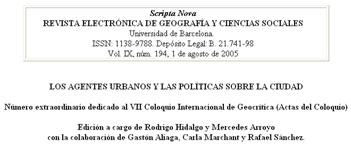The Economical Restructurization and Territorial Refuncionalization in Mexico: Its impact on the regional and urban systems in Mexico 1980-2000
Keywords:
Restructurization, Refuncionalization, Urban-regional system, Metropolization, MegalopolitzationAbstract
The impact that has been brought to the different regions and the urban systems (of Mexico); the changes in the economical structure of the country, bringing about a regional re-adaptation creating a dependency on transnational capital and excluding vast regions of development; as well as outlining a tendency of the metropolization of the national urban system, and the ever increasing number of cities which are surpassing their political-administrative limits. Because of this, on a regional level, we have a country with the following characteristics. The Northern Region, with a zone of assembly plants along the border and a few “toyotist” cities, along the northwestern border with California and Arizona and the northeastern border with Texas. According to some authors such as Hiernaux, Villareal and Delgadillo, among others, this region is a second border. Between this second border and a third border, whose boundary line is the city of Puebla, are the metropolitan zones that form a well-defined triangle that makes a dynamic hub of regional development: to the north we have Monterrey, to the west is Guadalajara and to the south, Mexico City. Finally, to the south we have a third border in this country; the south/southeast region, which, with the exception of tourist areas, has been excluded from the economical development. By means of the Plan Puebla Panama, the hope is that (this region) will begin experiencing growth by meeting the need for natural resources for large corporations of the global economy. With respect to the national urban system, there is a deepening imbalance of our system of cities; with a tendency towards growth among the metropolises that by 1995, six of which had more than one million inhabitants. It is important to note that in the case of the metropolitan zone of Mexico city, (ZMCM) its growth rate has raised to 2 % annually, which is a consequence of the megapolization process that is happening in this urban space and by the year 2000 will house over 23 million inhabitants. This mode of urban growth increases the regional inequalities as the principal economic activities are concentrated in the metropolitan areas. However, what is most significant is that the urbanization reflects those changes in the structure of the national economy. This is characterized by a process of oligopolistic centralization of capital, principally of foreign origin, which speeds up the country’s economic activity depending on the needs of the “globalization”. The resulting economical metamorphosis of this globalizing dynamic is expressed in the strengthening of a territorial organization with three hegemonic, polycentric regions: the megalopolis of Mexico City and the metropolises of Guadalajara and Monterry, which are accelerating the economical and regional development of the entire country.Downloads
Published
2007-06-07
Issue
Section
Articles
License
Los autores que publican en esta revista están de acuerdo con los siguientes términos:
- Los autores conservan los derechos de autoría y otorgan a la revista el derecho de primera publicación, cin la obra disponible simultáneamente bajo una Licéncia de Atribución Compartir igual de Creative Commons que permite compartir la obra con terceros, siempre que estos reconozcan la autoría y la publicación inicial en esta revista.
- Los autores son libres de realizar acuerdos contractuales adicionales independientes para la distribución no exclusiva de la versió de la obra publicada en la revista (com por ejemplo la publicación en un repositorio institucional o en un libro), siempre que se reconozca la publicación inicial en esta revista.





